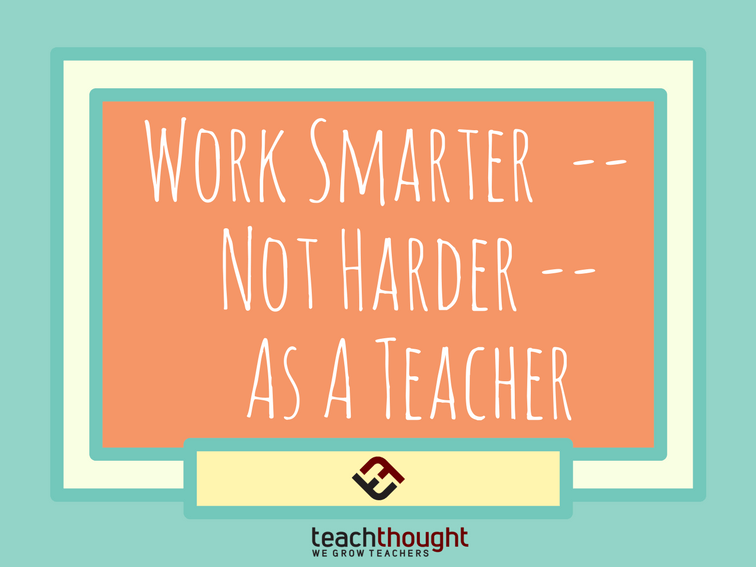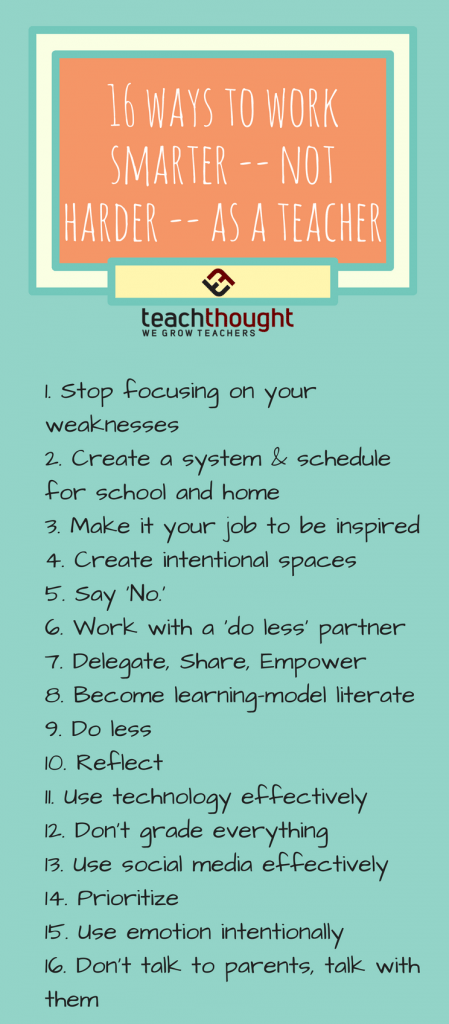
How To Reduce Your Teacher Workload
by Terry Heick
Teaching is hard.
There are many ways to reduce your teacher workload–to work smarter and not harder as a teacher.
Working ‘less hard’ may seem counter-intuitive, but it’s important to do so because teaching as a calling is important. The result is that we push ourselves–and are pushed by others–to be as close as we can be to perfect. This may not be our best thinking.
In public education, defined in terms and standards that it defines and measures itself by, perfect teaching means bringing every child to master every academic standard, then to be able to prove that mastery on a government-designed test.
This is a tragically limited view of knowledge, societal trends, and human potential, but let’s just accept that in 2020, that’s just where and what education ‘is’; to argue against this definition the work of innovation and progressive thinking and clean-sheet learning design, and that’s not what this post is about.
This post is about helping teachers.
So below, I’ve listed some strategies to save teachers time, effort, angst, or wasted potential. The big idea is helping you work smarter, and not harder, as a teacher.
While the benefits of smarter-not-harder-teaching include less mental and physical fatigue and likely more contentment as a professional and sustainability in your career, perhaps the most critical boon is to your creativity and inner genius: A cluttered mind burdened with task and tedium can’t readily achieve its own potential. There are warning signs of teacher burnout–don’t overlook them.
So many teachers are amazingly gifted, but never quite find the space in their own mind and heart to bring it all together at the same time, and after four or five years of mediocrity, just accept that that’s what ‘they are’ or what ‘education is.’ And it doesn’t have to be that way.
As it is, the field of education focuses on weaknesses and accountability and certification and data and committees and compliance. There is little room for greatness or reward for innovation or flexibility for the kinds of risk-taking and genius that innovation requires. If we want amazing teachers, we need to quit making it so difficult to be amazing.
Right, so, on to the list. 16 seems like a lot of tips, but not all will work for everyone. If you can just find two or three that help, that’d be a good start.

16 Ways To Reduce Teacher Workload
1. Stop Focusing on Your Weaknesses
There are certain things you do well–some even exceptionally well. Use those to drive your teaching. Whether you’re creative, energetic, charismatic, forward-thinking, organized, effortlessly collaborative, hip, intellectual–whatever you are, use it.
By all means, if you’re not strong with technology or classroom management or assessment or data, work to bolster those weaknesses. But as you plan your own teaching and the growth of your career, work backward from your strengths as you shift from working harder to working smarter.
2. Create a System and Schedule for School and Home
Sometimes you need to bring work home, and sometimes you’ll need to bring home to work. That’s part of being a human being.
But smart teaching requires a system and a schedule–some way to organize your priorities and workflow. Rules for grading (e.g., everything is graded within 48 hours or we grade it as a class or use self-assessment), rules for using your planning period (e.g., no cellphone), or rules for what work you let yourself take home (e.g., consider refinement of unit plans based on what you’re seeing in class as ‘okay’ to do at home while ‘grading papers’ not)–anything that creates a kind of system you can depend on and refine as you go along that keeps you from unchecked inefficiency and long nights staring bleary-eyed at papers.
This is a simple way to reduce your workload as a teacher.
3. Make it Your Job to be Inspired
Being inspired and curious and enthusiastic and full of wonder are prep-requisites for excellence in most ‘fields’ and domains. Protecting your inspiration and your gifts and your little guilty pleasures as a teacher is as critical as being able to quiet a noisy classroom or extract takeaways from data.
4. Create Intentional Spaces
Physically and digitally, create specific spaces to organization, creativity, technology, neurology, etc.
As a metaphor, think Pinterest boards for each area crucial to your success as a teacher, but not just Pinterest — think communities and books and social media channels and online courses and websites and small-scale PLNs and whatever else you need as a teacher. If it’s important to you, make it a priority — and making a literal ‘space’ for it can make that possible.
5. Say ‘No’
You have to be selective here, of course. Don’t tell that student that needs you ‘no,’ or your principal when they ask for documentation for something. But set clear boundaries for yourself and your time that make great teaching sustainable for you. You’re not good to students if you burn yourself out.
6. Work With a ‘Do less’ Partner
Kind of like a workout buddy–someone to keep you company, share tips and ideas with, or hold one another accountable for working less–to reduce your workload as a teacher.
7. Delegate, Share, Empower
These are classic ‘save yourself time’ strategies. If not done well, they can end up costing you more time than they save; even done intelligently there can be an implementation dip. But get them right and stick with them, and others can grow alongside you as a teacher.
By delegating the right tasks to the right people, you can save time and increase the capacity of students. Delegate the creation of study cards, the creation and ongoing updating of a ‘homework’ folder for students that miss class, the editing and uploading and tagging of video for a flipped classroom, maintenance of the class website, use of class social media–what would actually help here depends on your classroom, but the lesson remains: spread the burden–and opportunity–of the day-to-day operation of your classroom.
You can share, too. Share lessons with other teachers. Share data — or share the administrating of data-giving fluency probes or mini-assessments. Share the responsibility for maintaining the bulletin board down at the end of the hall. Share apps through an iCloud account. Share the work of proactively calling home to parents by rotating with other teachers on your team or in your department. You get the idea.
Empowering those around you can make for smarter teaching, too. This is a lot like ‘delegating,’ but with more freedom. Instead of delegating a specific task, you can empower a student with autonomy for a specific purpose so that they can identify necessary tasks, then complete them and revise needs accordingly. For example, instead of delegating the changing of pictures for the proverbial bulletin board down the hall, you empower them to use the board entirely at their own discretion. They decide what it’s used for and how to make it happen. Oversight is necessary, but by delegating your workload as a teacher is reduced.
And that’s smart.
8. Become Learning-Model Literate
Learning models are powerful strategies for innovation in education–and a way to work smarter, not harder as a teacher. A learning model is really just an approach for learning–a pattern or sequence or set of strategies and values designed to promote learning. Each usually has a certain shtick — a problem it addresses or a benefit it seeks to provide.
The flipped classroom, for example, is a model that simply ‘flips’ the kinds of work students do at home and what they do at school. One ‘drawback’ is the demand for technology, but a benefit is an opportunity for improved ongoing learning feedback as they practice new skills. This has the potential to save you time as a teacher, but that (obviously) can’t happen if you don’t A) Know what a ‘flipped classroom’ is and B) Understand exactly how it might work and C) Know the ins and outs to really optimizing its function to help students.
The more you’re aware of emerging trends and models, the more you can bring bits and pieces into your classroom for practice, or even adapting new frameworks outright to further reduce your workload as a teacher.
9. Do Less
Not everything you do needs to be done. It’s not always easy to see that in real-time, but in hindsight, it can be clear. Not all tasks are equally valuable.
10. Reflect
See #9. Strong and consistent reflection is the closest you’ll ever come to being able to predict the future.
11. Use Technology Effectively
Tech, done well, can save you an extraordinary amount of time. Seeing patterns in student errors through data analysis. Giving voice feedback to student writing. Creating quizzes that grade themselves. Empowering students for self-directed learning through carefully curated resources and networks. Automatic curation of select project-based learning artifacts. Notifications sent home. Sharing student work with parents with the push of a button.
Learn what tech does what, and start experimenting.
12. Don’t Grade Everything
And even what you do grade, consider only grading the work smarter for specific items that are most likely to benefit that student for that skill that they need the most.
13. Use Social Media Effectively
Like #11, using social media can save you time by reducing communication barriers, increasing the relative velocity of information, scale certain tasks effortlessly, creating visibility for student progress, and more. Use social media effectively, then help students do the same.
14. Prioritize
This is similar to #9. Know what’s most important, and do more of that to reduce your workload as a teacher. Identify what’s less important, and do less of that.
Prioritization isn’t rocket science, you’ve just got to have the courage to do it.
15. Use Emotion Intentionally
Emotion is what drives us as human beings. Affection, curiosity, insecurity, hope. Love. ‘How’ to use emotion to teacher smarter is probably a little esoteric, and this post is already almost 2000 words so I’ll just stop short and say that emotion is what energizes you — and is also what fatigues you.
And students.
Know what kinds of thoughts and activities and projects and grouping activities and patterns cause what sorts of emotions, and you can begin to master the art of teaching.
16. Talk *with* rather than *to* parents
Talk with them. Not all will be able to ‘help,’ but we can agree that it’s ‘smart’ to have parents at least on the same page with you as a teacher, and talking to–or worse, down to–them is the quickest way to make sure that doesn’t happen.
It’s difficult to get busy parents on board with over-worked teachers to help over-tested students, but what’s the alternative? To whatever degree you are able, collaborate with them instead.
At worst, they’ll ‘know what’s going on at school,’ and at best they just might surprise you with support, resources, ideas, and other avenues to make your life easier, and student outcomes more compelling and enduring.
